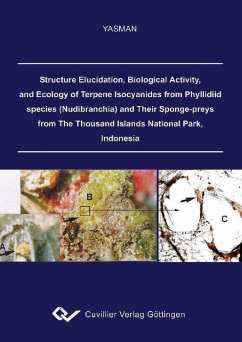Phyllidiids field feeding observations and isolation of isocyanide compounds both from phyllidiid species and from their sponge-preys have been done in order to assess the predator-prey relationships between phyllidiid species and their sponge-preys. Field studies and sample collections were done in the coral reefs of Thousand Islands, Indonesia while chemical studies were done in the Institute of Pharmaceutical Biology and Biotechnology, Heinrich-Heine University of Düsseldorf. In this study, phyllidiid species were found to feed exclusively on sponges from the order Halichondrida, especially the species that have no ectosomal skeleton. A possible reason for this choice is that phyllidiids need less effort to predigest the sponge’s epidermis, contact with the mesohyl of sponges becomes easier, resulting in an easier predation. Interestingly there is no specific correlation between pharyngeal bulb morphology of phyllidiid species with their specific sponge-preys. Of ten collected phyllidiids, six species (P. varicosa, P. zeylanica, P. pustulosa, P. krempfi, P. shireenae, and F. menindie) tend to be specialist predators on the sponge Axinyssa spp. (fam. Halichondriidae) while three species (P. lizae, P. rudmani, and P. ocellata) and one species (P. elegans) tend to feed exclusively on the sponges Acanthella cavernosa (fam. Dictyonellidae) and Dragmacidon sp. (fam. Axinellidae) respectively. The identification of collected sponges was done by the author himself under the supervision of Dr. van Soest (Zoological Museum of Amsterdam). The identification was based on the spiculation types and the size of fully grown spicules as well as on morphological data.
Dieser Download kann aus rechtlichen Gründen nur mit Rechnungsadresse in A, B, BG, CY, CZ, D, DK, EW, E, FIN, F, GR, HR, H, IRL, I, LT, L, LR, M, NL, PL, P, R, S, SLO, SK ausgeliefert werden.


